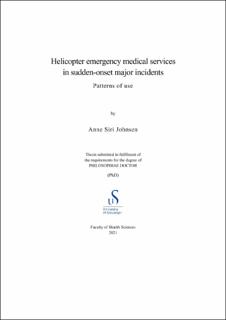| dc.contributor.author | Johnsen, Anne Siri | |
| dc.date.accessioned | 2021-05-27T09:21:37Z | |
| dc.date.available | 2021-05-27T09:21:37Z | |
| dc.date.issued | 2021-05 | |
| dc.identifier.citation | Helicopter emergency medical services in sudden-onset major incidents: Patterns of use by Anne Siri Johnsen, Stavanger : University of Stavanger, 2021 (PhD thesis UiS, no. 589) | en_US |
| dc.identifier.isbn | 978-82-8439-007-9 | |
| dc.identifier.issn | 1890-1387 | |
| dc.identifier.uri | https://hdl.handle.net/11250/2756563 | |
| dc.description.abstract | Major incidents happen infrequently and challenge the health care system by demanding more resources than are readily available. Critically injured patients need rapid treatment and swift transport to the right hospital to prevent unnecessary death and disability.
Helicopter emergency medical services (HEMS) are incorporated into emergency medical systems in Norway and other countries around the world. Anecdotally, HEMS have become integrated in the immediate management of sudden-onset major incidents and case reports depict that helicopters may play a key operational role. Although the amount of research on benefits and challenges of HEMS is rapidly growing, the optimal use in major incidents remains unanswered.
The main aim of this thesis is to explore the use of HEMS in sudden onset major incidents in a systematic way from different angles. The thesis focus on optimizing HEMS role in sudden-onset major incident management by sharing experiences for policy makers to improve major incident preparedness. This is done through four studies, a systematic review, a cross-sectional study, a Delphi study and a retrospective observational study.
With these studies, we found that previous research published on HEMS role in sudden-onset major incident management are mainly case reports and that little systematic research has been done. In the cross-sectional study and the retrospective observational studies, we found that HEMS participation in sudden-onset major incidents are rare in Norway. The cross-sectional study showed that HEMS personnel were experienced but only a little more than half of the crew members had attended a major incident within the previous five years. Further, the retrospective observational study showed that in a major incident, HEMS treat more patients on-scene than they transport to definite care. In this complex environment, the participation of multiple emergency services that not necessarily cooperate on a daily basis makes communication and coordination (including with HEMS) challenging. These challenges deserve focus in major incident training and planning.
To provide a better knowledge base for future research, data collection from major incidents and major incident exercises should be done systematically. The template developed in the Delphi study would enable other clinicians and researchers to submit structured open access reports, to share lessons learnt, collate data and compare major incident responses. The lack of a universally accepted definition of major incidents and removal of barriers in recruiting reports to the template remain important areas for future research. To enhance the knowledge on HEMS in major incidents, it remains pivotal that the pre-hospital environment acknowledges and address these challenges. | en_US |
| dc.language.iso | eng | en_US |
| dc.publisher | University of Stavanger, Norway | en_US |
| dc.relation.ispartofseries | PhD thesis UiS; | |
| dc.relation.ispartofseries | ;589 | |
| dc.relation.haspart | Paper 1: Johnsen AS, Fattah S, Sollid SJM, Rehn M. Utilisation of helicopter emergency medical services in the early medical response to major incidents: a systematic literature review. BMJ Open. 2016:6:e010307. doi:10.1136/bmjopen-2015-010307 | en_US |
| dc.relation.haspart | Paper 2: Johnsen AS, Sollid SJM, Vigerust T, Jystad M, Rehn M Helicopter emergency medical services in major incident management: A national Norwegian cross-sectional survey. PLoS ONE. 2017;12:e0171436. doi:10.1371/journal.pone.0171436 | en_US |
| dc.relation.haspart | Paper 3: Fattah S, Johnsen AS, Sollid SJM, Wisborg T, Rehn M, HEMS Major Incident Reporting Collaborators. Reporting Helicopter Emergency Medical Services in Major Incidents: A Delphi Study. Air Med J. 2016;35:348-351. doi:10.1016/j.amj.2016.08.003 | en_US |
| dc.relation.haspart | Paper 4: Johnsen AS, Samdal M, Sollid S, Rehn M. Major incident management by helicopter emergency medical services in south-east Norway from 2000 to 2016: Retrospective cohort study. Acta Anaesthesiol Scand. 2020;64(7):1014-1020. doi:10.1111/aas.13583 | en_US |
| dc.rights | Copyright the author | |
| dc.subject | akuttmedisin | en_US |
| dc.subject | luftambulanse | en_US |
| dc.subject | helicopter emergency medical services (HEMS) | en_US |
| dc.title | Helicopter emergency medical services in sudden-onset major incidents: Patterns of use. | en_US |
| dc.type | Doctoral thesis | en_US |
| dc.rights.holder | ©2021 Anne Siri Johnsen | en_US |
| dc.subject.nsi | VDP::Medisinske Fag: 700::Klinisk medisinske fag: 750::Traumatologi: 783 | en_US |
